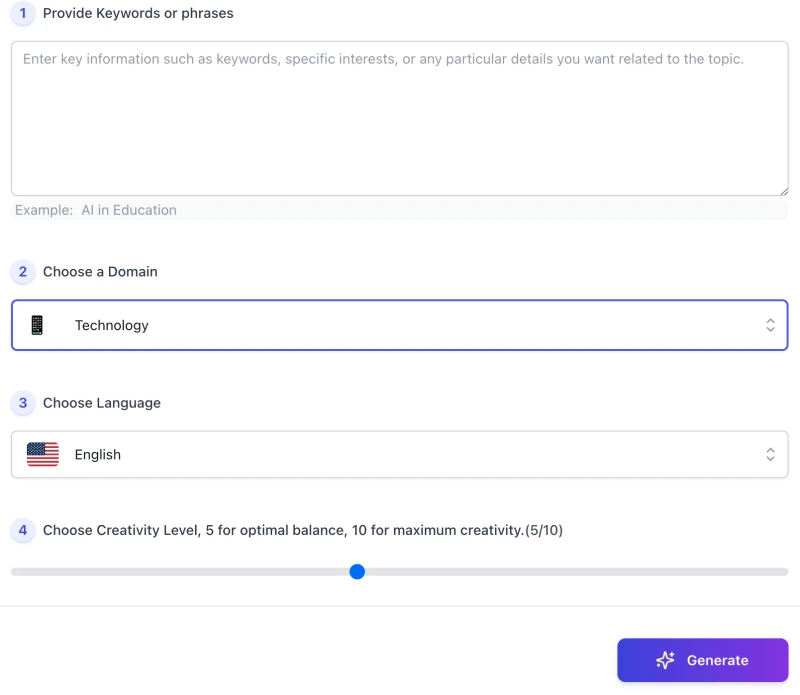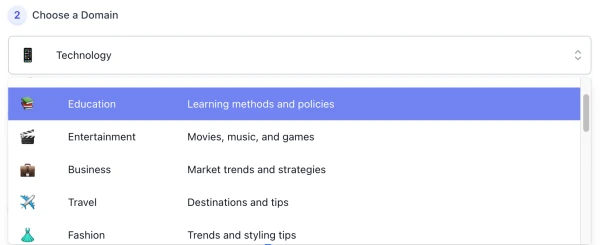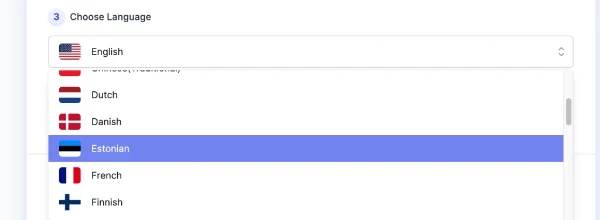Free AI Tools. No Sign-Up Required. Full Access.
AI Topic Generator
Free AI online tool to discover unique and inspiring topics — no sign-up, perfect for writers, teachers, and creative thinkers.
Combine the current tool with these other tools to work more efficiently.
Discover other tools with functions and purposes similar to the one you are currently viewing.
Discover the tools most favored and highly-rated by users on our website.
Explore more AI tools in these related categories
AI tools that generate, or optimize written articles and content for various purposes.
AI tools that automatically create text content for your images, audio, or video from user prompts.
AI tools that generate, brainstorm, or enhance creative concepts, ideas, and inspiration.
This is the AIFreeBox AI Topic Generator page—an online tool designed to support the early stages of content creation. It helps creators discover focused, practical, and angle-rich topic ideas based on their keywords and intended direction, making it easier to move from concept to clarity. Available on Free and Ultra Plan.
This page provides a full overview of the tool’s capabilities, usage scenarios, step-by-step guidance, practical tips, known limitations, common issues and how to address them, along with helpful FAQs.
What AIFreeBox Topic Generator Can Do
AI Topic Generator is designed as a lightweight yet capable idea engine for the earliest stage of content creation. It uses a custom fine-tuned large language model, based on transformer architecture, to analyze your input keywords and domain preferences—to uncover topic ideas that are relevant, well-angled, and ready for development.
Unlike generic idea tools, this generator focuses on direction over randomness. It doesn’t just suggest titles—it proposes structured entry points for writing, thinking, and creating across industries and formats.
The tool supports 33 languages and offers 31 categorized topic styles, giving users full control over tone, theme, and context. Whether you’re writing about travel, AI, or parenting, it adapts to the nuance of your field to offer suggestions that feel specific, usable, and worth building on. Its core value lies in helping you turn vague ideas or loose themes into actionable, high-quality topics—quickly, and with clarity.
AIFreeBox Topic Generator vs. Generic Random Topic Generator
Choosing the right tool can make the difference between random ideas and meaningful, direction-driven topics.
| ⚙️ Category | AI Topic Generator | Generic Random Topic Generator |
|---|---|---|
| 🎯 Input & Intent | Focuses on user keywords and creative direction | Ignores intent, produces random topics |
| 🧠 Generation Logic | Context-aware, based on semantic understanding | List-style randomization, no contextual logic |
| 📈 Relevance | Aligned with user’s goals and chosen domain | Often off-topic or unrelated |
| 🧩 Structure & Angles | Offers multiple viewpoints (trend, issue, insight) | Flat structure, limited depth |
| 🎚️ Control | Adjustable creativity and domain selection | Few or no customization options |
| 🌍 Language & Style | Supports 33 languages and 131 categorized styles | Usually monolingual and style-neutral |
| 💼 Use Scenarios | Best for planning, outlining, and brainstorming | Suited for quick, casual idea prompts |
| ✅ Practical Output | Usable, well-angled topics ready for expansion | Needs heavy editing and filtering |
Use Cases & Practical Value
| Who It’s For | Pain Points Solved | Why This Tool Works |
|---|---|---|
| Bloggers & Writers | Struggle to come up with fresh, relevant content topics | Generates well-angled, SEO-friendly topic ideas based on keywords |
| Content Creators & Influencers | Lack of inspiration or too many vague ideas with no structure | Offers structured prompts tailored to different styles and niches |
| Marketers Strategists | Need to fill editorial calendars or target long-tail keywords | Supports over 31 topic categories and 33 languages for global campaigns |
| Educators & Course Creators | Unclear where to begin when building lesson or content outlines | Generates thematic topic clusters for structured learning paths |
| Social Media Managers | Difficulty creating consistent post topics across channels | Generates short-form ideas with clear angles for reels, tweets, and captions |
| Founders & Thought Leaders | Unsure how to articulate insights into content that builds authority | Provides idea hooks aligned with tone and domain of expertise |
| Non-native Creators | Language barrier in brainstorming or framing content ideas | Multi-language support (33 languages) for globally accessible ideation |
How to Find a Topic with AIFreeBox AI: Step-by-Step Guide

This tool is designed to be simple and efficient. Follow the steps below to generate topic ideas tailored to your input and intent.
1. Provide Keywords or Phrases
Enter any core ideas, specific interests, or detailed descriptions you want the topics to be based on. This could be as simple as “AI in Education” or more specific like “ethical concerns of facial recognition in schools”. The more focused your input, the more aligned the results.
2. Choose a Domain

Select the topic category that best matches your intent. The tool supports 31 categorized domains such as Technology, Business, AI, and more. This helps the AI frame the output within a relevant context.
3. Choose Language

Pick the language you’d like your topics to be generated in. The tool supports 33 different languages to accommodate global users and multilingual content needs.
4. Set the Creativity Level
Use the slider to adjust the creativity level of the output. A value of 5 offers balanced, usable ideas; higher values (up to 10) produce more experimental or unconventional suggestions. This gives you control over tone and innovation.
5. Click Generate
Once all selections are made, click the “Generate” button. You’ll receive a list of curated topic suggestions based on your inputs—ready to inspire your next blog post, article, campaign, or project.
Step 6: Review, Copy, or Download
After generation, you can easily Download or Copy the results for your workflow—ideal for saving reference ideas or sharing with a team.
Step 7: Report a Bug (Real Human Support)

If you encounter any issues, click the Report Bug button. A real human support team will review your message and respond as soon as possible. Your feedback directly helps improve the tool and ensures a smooth user experience.
Remember: Each topic generated by the AI is designed to be a structured, reference-worthy suggestion—bridging the gap between vague ideas and clear creative direction. The AI analyzes your input, interprets intent, and provides meaningful starting points. You, as the creator, refine and personalize them to make every topic align with your unique goals and audience.
Tips & Best Practices
Part 1: Getting the Results You Want
- 📌 Start with a clear direction. Don’t just type a single word — give the AI some context. For example, instead of “marketing,” try “digital marketing trends for small businesses.”
- ✨ Be specific about your focus. Include time, audience, or platform details like “Gen Z fashion trends 2025” or “AI in video storytelling.” It helps the AI understand your intent better.
- 🧩 Choose the right domain. Each domain fine-tunes how the AI interprets your idea. Selecting “Business” or “Education” changes the tone and direction of the suggestions.
- 🎚️ Adjust creativity consciously. Lower creativity levels (3–5) yield structured, factual topics. Higher levels (7–10) inspire more exploratory and creative results — ideal for brainstorming.
- 🔁 Experiment with phrasing. If the first output isn’t quite right, tweak your input slightly — even small wording changes can unlock fresh topic angles.
Part 2: Refining & Personalizing the Output
- 🧠 Review and select with intent. Treat AI suggestions as drafts. Keep the ones that align with your theme, and set aside others for later inspiration.
- 🪞 Add your voice and perspective. AI provides structure — you bring context and insight. Adjust tone, examples, or audience focus to make each topic your own.
- ✏️ Combine and refine ideas. Merge two or more AI-suggested topics into one stronger angle. For example, turn “AI in Education” and “Future of Online Learning” into “How AI is Redefining the Future of Learning.”
- 🎯 Check alignment with your goals. Before using, ask: “Does this topic speak to my audience or brand direction?” Adjust keywords or focus as needed.
- 💡 Use AI as a collaborator, not a substitute. The AI helps you find structure and inspiration — you decide what’s relevant, meaningful, and worth developing further.
These practices ensure the AI Topic Generator works with you — analyzing your input, understanding your intent, and offering structured ideas that help you move from vague concepts to clear, actionable creative direction.
From Input to Inspiration: A Real Example
Here’s how a focused fashion-related input can lead to useful, well-angled topic suggestions:
🎯 Input
- Keywords: Gen Z fall fashion trends
- Domain: Fashion
- Language: English
- Creativity Level: 5 (Balanced)
✅ Output Topics
- Top 10 Must-Have Pieces for Gen Z This Fall: A Trend Forecast
Explore the key items that will define fall fashion for Gen Z in 2025, including colors, fabrics, and styles. - Sustainable Fashion: How Gen Z is Shaping Eco-Friendly Trends for Fall 2025
Discuss the impact of sustainability on Gen Z’s fashion choices and highlight brands leading the way. - The Rise of Gender Fluidity in Fall Fashion Trends for 2025
Analyze how gender-neutral clothing is becoming a staple in Gen Z’s fall wardrobe, featuring examples from influencers and designers. - How to Style Vintage Finds: Embracing Nostalgia in 2025 Fall Fashion
Offer a guide on incorporating thrifted or vintage items into modern outfits, appealing to Gen Z’s love for unique styles. - Common Fashion Mistakes to Avoid This Fall: A Gen Z Perspective
Identify pitfalls in fall styling that many young adults make and provide tips on how to avoid them.
This example shows how even a short and targeted input can result in diverse, relevant, and structured topic ideas. The suggestions are not random—they reflect a clear thematic direction that the user can further refine or build upon.
Limitations & How to Handle Them
| Limitation | What You Might Notice | Suggested Fix |
|---|---|---|
| Too generic results | Topics feel broad or obvious, lacking direction | Use more specific input keywords or adjust creativity level |
| Misaligned domain suggestions | Results don’t match your field or audience | Double-check the selected domain; try rephrasing your input |
| Repetitive ideas | Several topics are variations of the same theme | Regenerate with slightly varied inputs or try a different creativity setting |
| Limited nuance in niche areas | Some topics feel surface-level for very specific industries | Supplement with your own expertise or combine AI output with manual editing |
| Language nuance issues | Minor phrasing errors or unnatural wording in non-English outputs | Review and lightly edit AI suggestions before publishing |
FAQs
Is the generated content ready to publish?
No. All topic suggestions are meant to serve as inspiration. You should review and refine the ideas to ensure they match your goals, tone, and audience before using them.
How specific should my input be?
More specific inputs typically lead to more focused and relevant results. Instead of entering a broad term like “technology,” try something like “AI applications in rural healthcare.”
What should I do if the topics feel too generic?
This usually means the input was too broad or the domain too general. Try rephrasing your keywords, narrowing your scope, or adjusting the creativity level.
Can I use this tool for non-English content?
Yes. The tool supports 33 languages. However, minor translation or phrasing edits may still be needed for natural flow and clarity.
Does this tool create complete blog posts or articles?
No. It only generates topic ideas. You can pair it with other tools like our AI Blog Generator if you need help writing full content.
Can I regenerate results without changing the input?
Yes. Re-generating with the same input may give different results, especially at higher creativity levels.
Is this tool suitable for academic or scientific content?
It can help with brainstorming, but the outputs may not capture field-specific technical depth. Use it as a starting point, then refine based on your expertise.
Are the results saved or stored?
No. Generated content is not stored or tracked. If you find useful topics, be sure to save or copy them before leaving the page.
Style System Overview
- 🎨 Technology — Topics about innovation, gadgets, and digital life. Perfect for creators writing about AI, software, or future tech.
- 💊 Health — Focused on wellness, lifestyle balance, and medical topics. Useful for content about fitness or healthy living.
- 📚 Education — Covers learning trends, teaching strategies, and study habits. Ideal for teachers, students, and edtech writers.
- 🎬 Entertainment — For movies, music, games, and pop culture stories. Great for blog or social content that feels fun and current.
- 💼 Business — Suited for marketing, startups, and workplace trends. Helps build professional or brand-related topics.
- ✈️ Travel — Inspires stories about destinations, culture, and tips. Perfect for lifestyle bloggers or tourism content.
- 👗 Fashion — Focused on trends, style guides, and seasonal inspiration. Great for creators in beauty or lifestyle niches.
- 🌍 Environment — Highlights sustainability, green living, and climate awareness. Ideal for eco-conscious storytelling.
- 🏅 Sports — For news, athlete stories, and motivational content. Engages readers around teamwork and competition.
- 🍽️ Food — From recipes to restaurant culture, this style adds flavor to any culinary content or lifestyle brand.
- 🎨 Art — Perfect for discussions on creativity, design, and visual storytelling. Appeals to artists, designers, and creators.
- 💰 Finance — Explores money management, investing, and the economy. Ideal for business blogs or educational guides.
- 🔬 Science — For discoveries, innovations, and curious minds. Brings clarity to complex ideas for general readers.
- ⚖️ Law — Covers legal updates, rights, and case insights. Useful for educational or professional content.
- 🚗 Automotive — Focused on vehicles, trends, and car tech. Great for enthusiasts and product reviewers alike.
- 🏡 Family — Topics around parenting, home life, and relationships. Works well for lifestyle and personal blogs.
- 📈 Career — Career advice, skills, and growth insights. Supports professional development and job-related writing.
- 🧠 Psychology — For mindset, behavior, and motivation topics. Helps explain human thinking in everyday terms.
- 📖 Literature — Focused on books, writing tips, and literary themes. A must for authors and readers alike.
- 🏛️ History — Explores past events, cultures, and key figures. Adds context and depth to modern discussions.
Creator’s Note
This tool wasn’t built to impress with complexity or promise effortless results. It was designed to help you begin—to give you a clear, thoughtful push in the direction you care about. Every topic it suggests starts with what you provide. The insight, the relevance, and the final shape of your work still come from you.
AI Topic Generator doesn’t aim to replace creative thinking—it exists to support it. Whether you’re writing, planning, or simply exploring, I hope it serves as a reliable tool that respects your voice and helps you work with more clarity, not less.
2025-10-22
🧩 Try it out now — free, online, and ready when you are.
Explore new ideas and perspectives — let AI help you spark creativity and start something original.